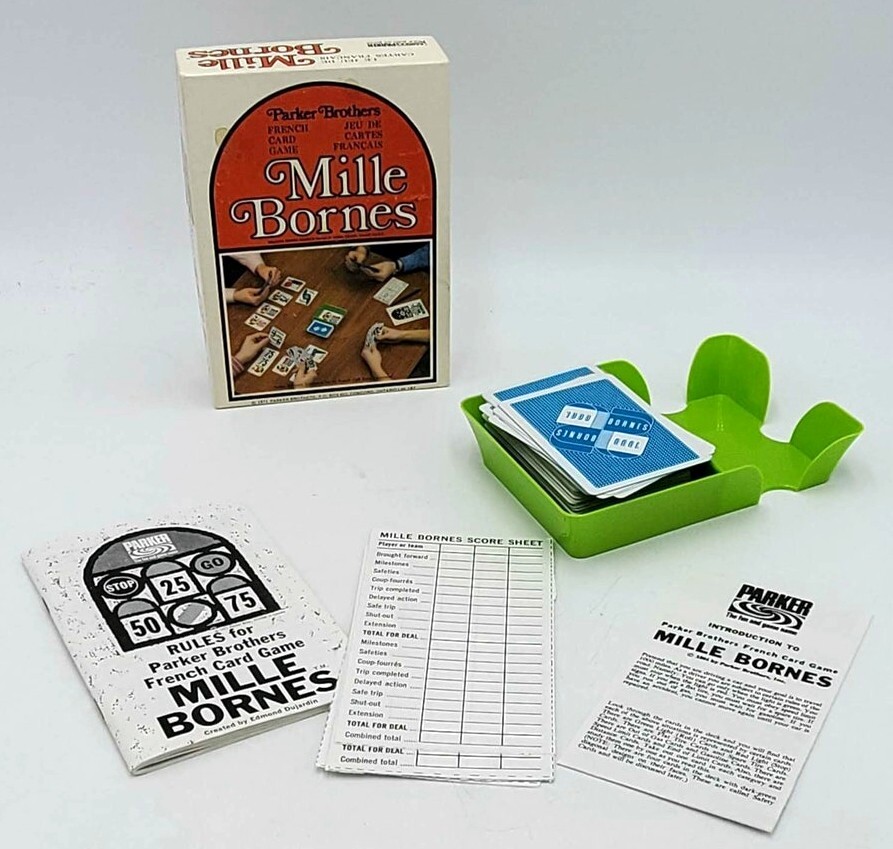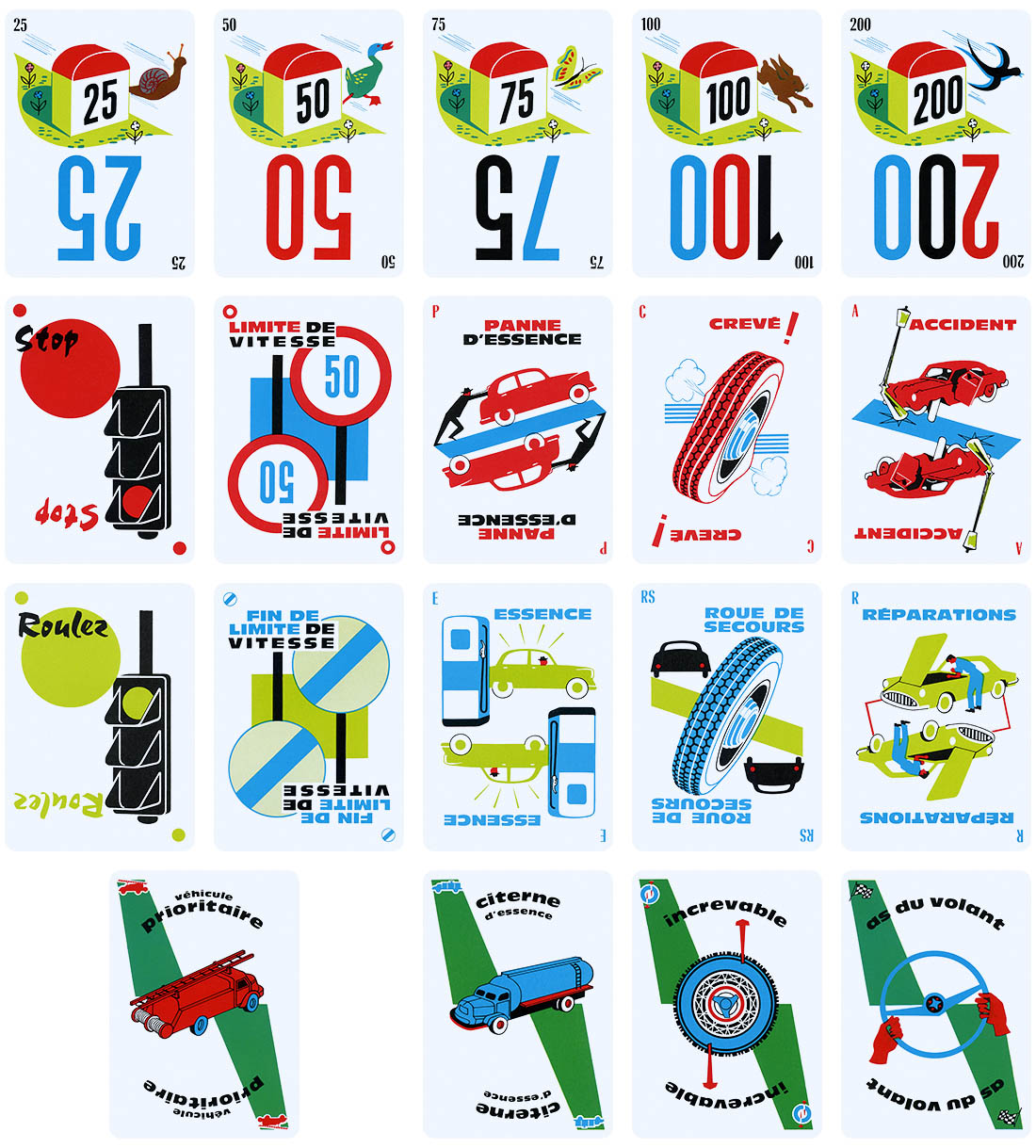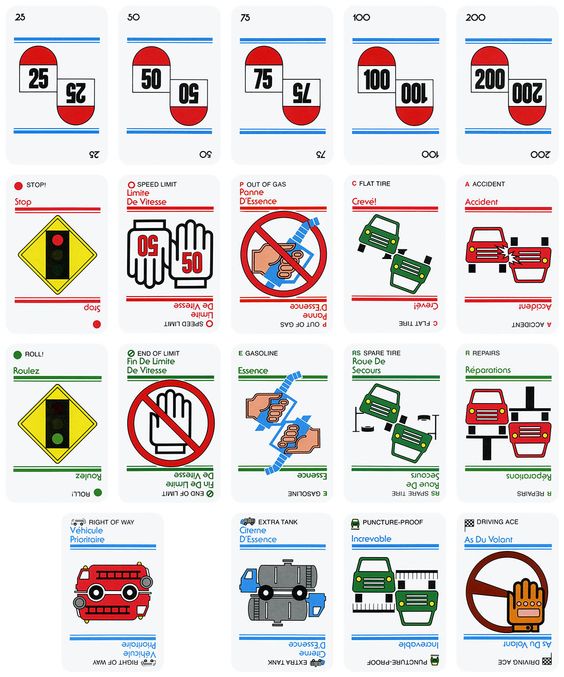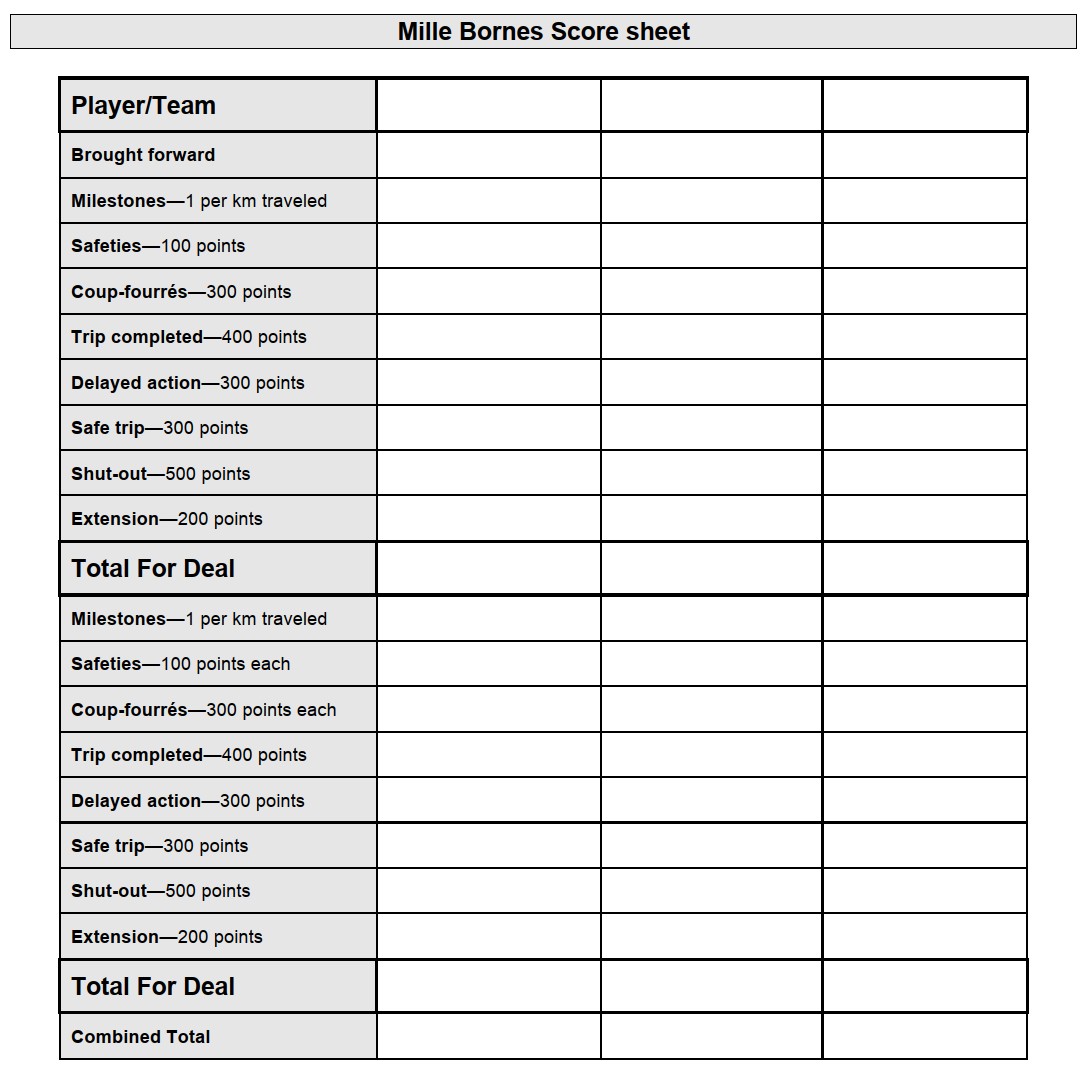
Milles Bornes English
Jeux
Jeux de Cartes / Card Games
Milles Bornes English 1971 PDF

1971


ANOTHER PARKER GAME
At Parker Brothers the search for new games with exciting play goes on continually, not only in Canada, but also abroad. We now proudly intro- duce to the Canadian public a truly fine game that has already become a popular craze in France. As always in our games, the very best materials have been used to insure lasting pleasure.
The rules have been carefully edited to make learning easy and the game has been tested and retested by experts and by novices alike to assure you of many happy hours of play.
In most of Europe (especially in France), along the roads, one sees small monuments of cement at regular intervals, bearing a figure and the name of a town. They are the kilometer-stones (in French: Bornes Kilometriques — in English: milestones), well known to motorists.
They show the number of the route as well as the distance to the next town. The red or yellow color of these stones show whether the route is a national highway or a local road. These are the markers which give this game .its name: MILLE BORNES (pronounced "Meel Born").
This is a card game for 2, 3, 4 or 6 players, usually played by 4 players, 2 on each team, as a partnership game. Therefore, the game will be described first in this form. Slight variations necessary for other number of players will be noted later.
1. OBJECT
The object of this game is to be the first team to accumulate a total of 5000 points in several hands of play. In so doing, players try to complete trips of exactly 1000 miles in each hand played.
2. EQUIPMENT
The equipment consists of a pack of 112 cards, a special card tray and scoring sheets. As players read the rules, they should look at the various cards and familiarize themselves with them. Six of the cards contain type only, and are designed to provide easy reference for play and for scoring. These cards should be removed from the pack before playing. The actual playing cards used in the game are shown in Diagram #1 and their purposes are described briefly in the succeeding paragraphs.


DISTANCE CARDS:
These are the cards with the milestones on them. Each one represents a distance of 25, 50, 75,100 or 200 miles. When played to the table, they are added together to determine the distance traveled.
HAZARD CARDS:
These cards are predominantly red and blue or red and black in color. They are played against your opponents to hinder their progress. They are played onto your opponents' Battle Pile on top of Roll Cards. (For the one exception to this rule, see paragraph on RIGHT OF WAY CARD.)
Under no circumstances may one Hazard Card be played directly on top of another Hazard Card. There are 18 Hazard Cards as follows: 3 OUT OF GAS CARDS, 3 FLAT TIRE CARDS, 3 ACCIDENT CARDS, 4 SPEED LIMIT CARDS, and 5 RED
LIGHT CARDS. REMEDY CARDS:
These cards are predominantly blue and light green or black and light green in color. They are played only on your own Battle Pile to overcome Hazard Cards that an opponent has played previously against you.
There are 38 Remedy Cards as follows: 6 GASOLINE CARDS, 6 SPARE TIRE CARDS, 6 REPAIRS CARDS, 6 END OF SPEED LIMIT CARDS, and 14 ROLL CARDS.
SAFETY CARDS:
These cards can be distinguished by the dark green diagonal design. They are used to prevent an oppo- nent from playing certain Hazard Cards against you later.
There are only 4 of these cards, 1 each of the following: EXTRA TANK, PUNCTURE- PROOF, DRIVING ACE, and RIGHT OF WAY.
CARDS NOT USED IN PLAY:
There are 6 cards NOT used in the play of the game. They are: 2 Score Cards printed in English, 1 Score Card printed in French, 2 Card Guides printed in English, and 1 Card Guide printed in French.
3. PREPARATION
Partners sit opposite each other. The empty card tray is placed in the center of the table.
One player is selected as dealer. After removing the 6 cards not used in play, the dealer shuffles the entire deck and then deals 6 cards face down, one at a time, to each player starting with the player to his left.
He then places the remaining cards face down in the section of the tray which has open sides for easy drawing. These cards form the draw pile. Each player holds his cards without showing them to the other players.


4. HOW CARDS SHOULD BE DISPLAYED
Before starting play, each player should understand how cards are played to the table as shown in Diagram #2 and as described in the following rules. This special placement makes the game easy to follow and prevents errors in scoring at the end of each hand. Cards played to the table are always played face up so that all players can see them.
BATTLE PILES:
All Hazard and Remedy Cards are played on the Battle Piles with the exception of the Speed Limit and the End of Limit Cards. Hazard Cards are played on your opponents' Battle Pile and Remedy Cards on your own Battle Pile. Only the top card on each team's Battle Pile should be visible as it is the card which controls the play.
SPEED PILES:
Only the Speed Limit and End of Limit Cards are played on the Speed Piles. The former are played on an opponents' Speed Pile and the latter on your own Speed Pile. Only the top cards on each team's Speed Pile should be visible as it is the card which controls the speed.
SAFETY AREAS:
Only the 4 Safety Cards are played in the Safety Areas. Safety Cards are never played on your opponents' Safety Area. All Safety Cards that are played must be visible. When a Safety Card is played as a Prevention, it is aligned in the same direction as other cards.
When played as a COUP FOURRÉ, it is placed crosswise in the Safety Area. (The important COUP FOURRÉ play is fully described later in the rules.)
DISTANCE PILES:
All Distance Cards are played on your own Distance Piles. They are never played onto the opponents' piles. All Distance Cards that are played to the table must be visible so that any player can see how far you have traveled. It is best to keep these cards separated by mileage for easy checking as shown in Diagram #2.
5. THE PLAY
The player to the left of the dealer plays first. He draws a card from the draw pile and places it in his hand. He then must play one card from his hand so that at the end of his turn he again has six cards remaining in his hand. The first player after drawing a card must make one of the following four plays:
A. He has a Roll Card (Green Light), he may play it to the table face up in front of him to start his Battle Pile. His turn ends and play passes to the opponent on his left.
B. He has a Safety Card, he may play it face up in front of him approximately as indicated in Diagram #2. The play of a Safety Card at any time during the game entitles a player to an- other turn. He immediately draws another card from the draw pile and makes another play. If he has another Safety Card in his hand, he may play it and have still another turn, and so on.
C. He has a Speed Limit Card, he may play it in front of an opponent, even though his opponent has not yet had a chance to play and thus has no Roll Card exposed. This play starts his opponents' Speed Pile.
D. He is unable to make any of these plays, he must discard one card face up to the closed section of the tray starting the discard pile. Cards once discarded are out of play for the balance of the hand, and other players may not pick them up on their turn.
When the first player has completed his turn, the second player plays in the same manner. He may make any of the plays described above for the first player, but he has two additional possibilities.
If the first player has played a Roll Card, the second player may play a Hazard Card on top of his opponents' Roll Card.
If the first player played a Speed Limit Card against the second player's team, the second player may play an End of Limit Card on top of it. The third player then plays, but since he is a partner of the first player, he does not start any piles of his own. (In the partnership game, partners play to one set of piles.)
He plays either to his partner's piles or to his opponents' piles, having the same possible plays as the first and second players.
If, however, his partner has a Roll Card or a Right of Way Card exposed, he may play a distance card in front of his partner, starting the distance piles for his team.
The fourth player plays in a similar manner and play continues, in turn, around the table until one team has completed a trip of exactly 1000 miles, or until all of the cards in the draw pile and in the hands have been played (see DELAYED ACTION page 15).
At this point the hand comes to an end, scores are totaled, all of the cards are reshuffled and a new hand is started. Remember that a player's basic turn consists of drawing one card, adding it to his hand and then playing one card to the table or discarding one card to the discard pile. Thus, he always holds six cards in his hand at the end of each turn.
6.THE CARDS
The above brief outline of the game gives the general rules of play but the use of the individual cards requires more specific description.
A. HAZARD AND REMEDY CARDS
Hazard Cards are played onto your opponents' pile and Remedy Cards are played on your own team's pile. For each Hazard Card there are corresponding Remedy Cards.
A ROLL CARD (Green Light) must be displayed on your Battle Pile before your team can play any Distance Cards. (For the one exception to this rule, see paragraph on RIGHT OF WAY CARD.)
A STOP CARD (Red Light) is played only onto your opponents' Roll Card, to prevent them from playing further Distance Cards until they can cover it with another Roll Card on a subsequent turn.
A SPEED LIMIT CARD is played onto your opponents' Speed Pile along side their Battle Pile. While it is exposed, your opponents can only play 25 mile or 50 mile cards. As long as no cards are on your Speed Pile, you are not subject to any speed limit.
AN END OF LIMIT CARD is played onto your own team's Speed Pile, on top of a Speed Limit Card, to permit you to resume speed and play any mileage cards including 75,100 and 200 mile cards.
AN OUT OF GAS CARD is played onto your opponents' Roll Card. They cannot play further Distance Cards until they have first played a GASOLINE CARD and then a Roll Card on subsequent turns.
A FLAT TIRE CARD is played onto your opponents' Roll Card. They cannot play further Distance Cards until they have first played a SPARE TIRE CARD and then a Roll Card on subsequent turns.
AN ACCIDENT CARD is played onto your opponents' Roll Card. They cannot play further Distance Cards until they have played a REPAIR CARD and then a Roll Card on subsequent turns.
B. SAFETY CARDS
Safety Cards are played in your own team's Safety Area and prevent you from being stopped by the corresponding Hazard Cards. Once they are played, they are effective immediately and throughout the balance of the hand. Do not forget that the play of a Safety Card always entitles the person who played it to an extra draw and play.
RIGHT OF WAY CARD:
When displayed in your team's Safety Area, your opponents cannot play a Stop Card on your Battle Pile and cannot play a Speed Limit Card on your Speed Pile. This card when displayed permits you to play Distance Cards even though you do not have a Roll Card exposed.
You may also play 75, 100 and 200 mile cards even though a Speed Limit Card is exposed on top of your Speed Pile. Your opponents may, of course, stop you by playing OUT OF GAS, FLAT TIRE, or ACCIDENT CARDS onto your Battle Pile.
In this case you do not need to play another Roll Card but only the proper Remedy Card to be able to play Dis- tance Cards. This is also the only time an opponent can play a Hazard Card directly on top of any Rem- edy Card other than a Roll Card.
EXTRA TANK CARD: When displayed in your Safety Area, your opponents cannot play an Out of Gas Card onto your Battle Pile.
PUNCTURE PROOF CARD: When displayed in your Safety Area, your opponents cannot play a Flat Tire Card onto your Battle Pile.
DRIVING ACE: When displayed in your Safety Area, your opponents cannot play an Accident Card onto your Battle Pile.
C. DISTANCE CARDS
Distance Cards may be played at any time that a Roll Card is exposed on top of your Battle Pile. They may also be played when a Right of Way Card is exposed, unless you are stopped by an Out of Gas, a Flat Tire, or an Accident Card.
You may play any combination of Distance Cards that you are able to play to make 1000 miles, except that no more than two 200 Mile Cards may be used. Under no circumstances may you play Distance Cards that will bring your total over the 1000 mile mark.
For example:
If you have exposed in your Distance Piles cards totaling 950 miles, the 75,100, and 200 Mile Cards are of no use to you. The play of a 25 Mile Card gives you 975 miles or the play of a 50 Mile Card completes your trip. A hand ends when one side or the other completes a trip of exactly 1000 miles, or when the cards in the draw pile are exhausted.
In the latter case, players must play out or discard in turn the remaining cards in their hands. If the trip of 1000 miles is completed after all the cards in the tray are exhausted, the play is referred to as DELAYED ACTION and the hand ends.
7. COUP FOURRÉ (pronounced Coo-Foo-Ray)
Coup Fourré is a French fencing term for counter- thrust where one fencer parries his opponent's thrust and counter attacks in the same maneuver. In this game the action is much the same and operates in the following manner.
If an opponent plays a Hazard Card, and you hold the corresponding Safety Card in your hand, you may call "Coup Fourré" and immediately play the Safety Card to your Safety Area crosswise as shown in Diagram #2. You may make this play immediately whether or not it is your turn. If you make this play, you must make it BEFORE you draw a card and before any other player draws a card.
The "Coup Fourré" play entitles you to remove AT ONCE the Hazard Card from your Battle Pile, or Speed Pile in the case of a Right of Way Card, and place it on the discard pile.
Since you now have only 5 cards in your hand, you must draw one card to bring the number of cards held to six. In addition, because you have played a Safety Card, you are entitled to another turn so you immediately draw another card and play again.
The "Coup Fourré" play, because it permits the immediate removal of a Hazard Card, restores the situation that existed before the play of that hazard onto your Speed Pile.
If you had a Roll Card on top of your Battle Pile it will again be exposed. If you were in a position to play Distance Cards because you have previously played a Right of Way Card, you may continue to do so.
The Safety Card thus played also protects you from the correspond- ing Hazard Cards for the rest of that hand. When your turn is completed, the next player to your left plays, and play continues around the table in the usual manner. Any players between you and the player who played the Attack Card that made the "Coup Fourré" possible lose their turns.
8. SCORING
The score is totaled at the end of each hand, whether or not a trip of 1000 miles was completed, as follows:
Each team scores as many points as the total number of miles that it has traveled x
Each Safety Card played 100 Additional bonus if all four Safety Cards are played by the same team 300
Each Coup Fourré (note that this score is in addition to the 100 points scored for playing a Safety Card.) 300
Bonus for completing trip of 1000 miles 400
Additional bonus if trip is completed after all cards have been played from the draw pile (Delayed Action) 300
Additional bonus if trip is completed without playing any 200 Mile Cards (Safe Trip) .... 300
Additional bonus for shutting out opponents (Completing trip of 1000 miles before opponents have played any Distance Cards).... 500
Score sheets are included with the game which provide spaces for all possible types of scoring. After the first few games, these sheets will not be necessary and scores may be kept on any piece of paper. For quick reference there is also a card included in this game which lists all possible scores.
9. WINNING THE GAME
Winning the game: All points for each side are totaled at the end of every hand, and these totals are carried forward to the next hand. A game will usually consist of several hands. The team that first scores 5000 points, or, if both sides exceed 5000 points on the same hand, the team with the highest total points wins the game.
10. RULES FOR 2 OR 3 PLAYERS
In a game of 2 or 3 players, each plays for himself and displays his own game piles in front of him. Play is the same as in the four-handed partnership game with the following exceptions:
A. Before the deck is shuffled, remove one each of the following cards: Red Light, Accident, Out of Gas, Flat Tire, and Speed Limit.
B. The distance of a trip is shortened from 1000 miles to 700 miles.
C. The Extension: This play is used in games with 2 or 3 players. The player who first succeeds in playing cards totaling exactly 700 miles may demand to continue the hand to 1000 miles. To do this, he must call "Extension" exactly at the time he reaches 700.
The hand then goes on until one of the players reaches 1000 or until no one has any cards left. Once the extension is asked for, the hand is played as though it had always been for a trip of 1000 miles.
The first person who reaches the 1000 miles scores the 400 points for the deal, even if he is not the one who called "Extension."
If the hand is not won by the "extension caller," or if it ends after all the cards have been played without either player reaching 1000 miles, the player who asked for the extension does not get the 400 points that he would have received had he stopped at 700.
In addition to the normal score, a bonus of 200 points is granted to the player who calls "Extenfail", the bonus is given to his opponent or opponents.
D. Scoring is the same as in the regular game with the exception of the extra points provided for in the extension play, as described above.
11. RULES FOR 6 PLAYERS
In the game for 6 players, the play is the same as in the four-handed partnership game with the following exceptions:
A. There are 3 sets of partners and they sit as shown in Diagram #3. A & D are partners B & E are partners C & F are partners

B. The distance is shortened to 700 miles.
C. The Extension (Refer to Section 9, Part C) is also used in this game.
D. The scoring is the same as in the game for 2 or 3 players.
12. HINTS FOR PLAY
In playing this game, the following hints may be helpful:
A. Keep the score cards and the guide cards (those not used in the play) on the table so that all play- ers can refer to them.
B. At the beginning of a hand, it is usually better to get a Roll Card on your Battle Pile rather than trying to play Hazard Cards against your opponents.
C. It is usually better to save your Safety Cards to play as Coup Fourré rather than playing them as preventions. However, do not hold them too long as you get no credit for them if they are still in your hand at the end of the game. Remember that a Safety Card can be played on any turn as a Prevention Card.
D. Do not hold cards in your hand that are of no value to you. Discard them at the earliest opportunity.
For example: a 200 Mile Card is of no value to you once you have played two of them to your Distance Pile. An Out of Gas card is of no value if your opponent has played the Extra Tank Card in his Safety Area, etc.
E. Try to remember which cards have been played. It is useless to hold a Remedy Card if all of the corresponding Hazard Cards have been used.
F. Do not forget to take an extra turn every time that you play a Safety Card either as a Coup Fourré or as a Prevention.
G. In scoring, remember that each Coup Fourré played gives you a bonus of 300 points as well as 100 points for playing a Safety Card. For example, if one player or team plays two Safety Cards as preventions and two as Coup Fourrés, he scores 400 points for playing Safety Cards, a bonus of 300 points because he played all four and 600 points for playing two Coup Fourrés.
H. You can play a Speed Limit Card on your opponent's Speed Pile even when he has a Hazard Card showing on his Battle Pile, or a Hazard Card on his Battle Pile when he has a Speed Limit Card showing on his Speed Pile.

